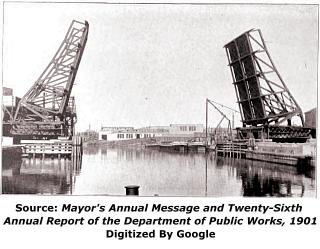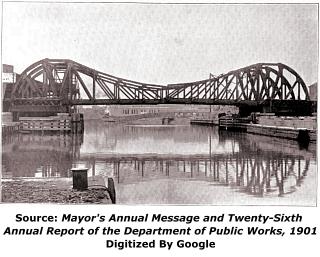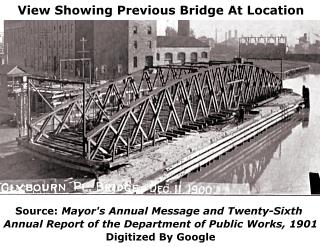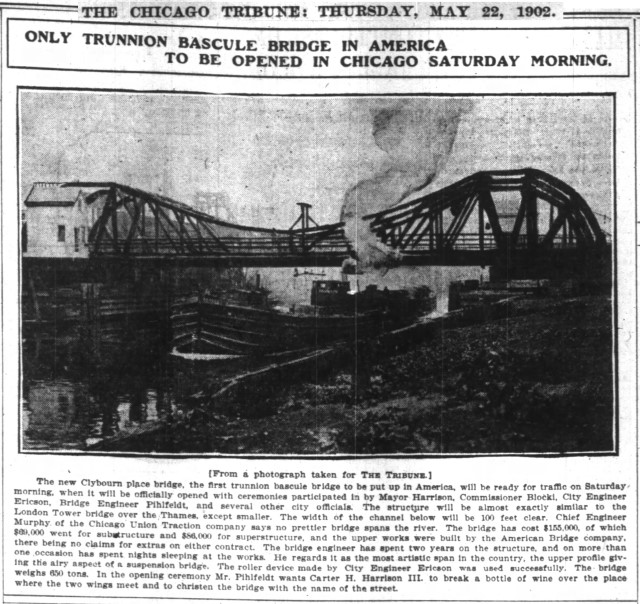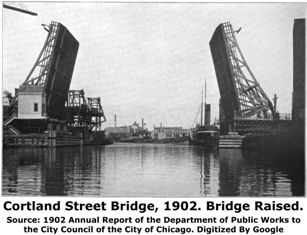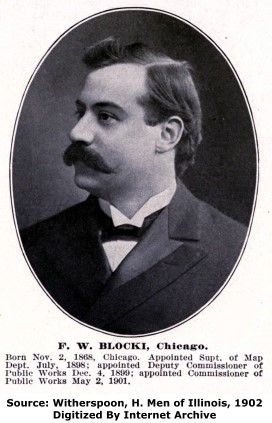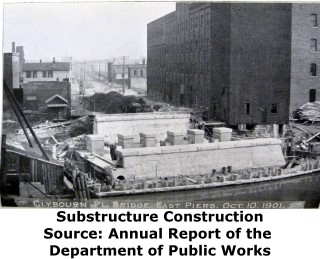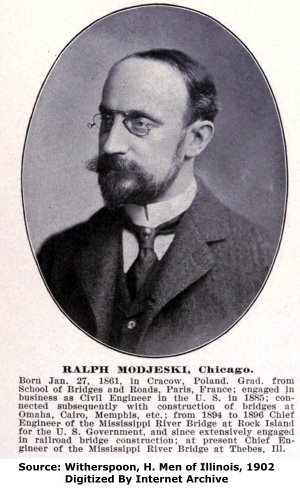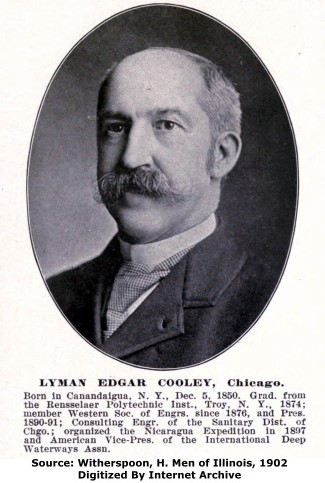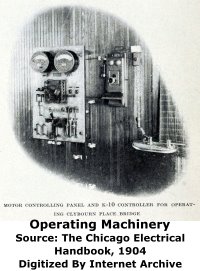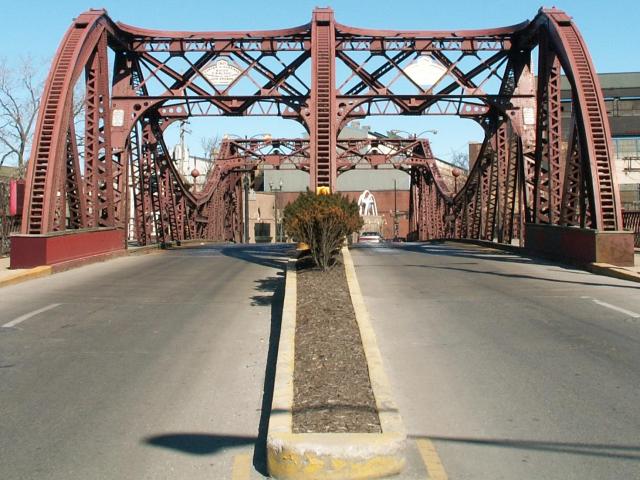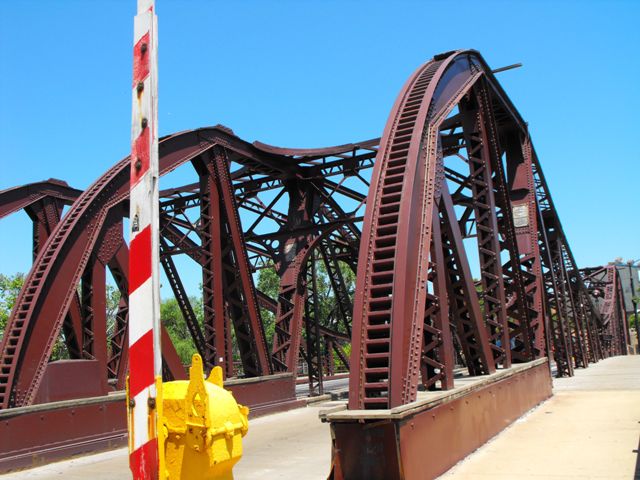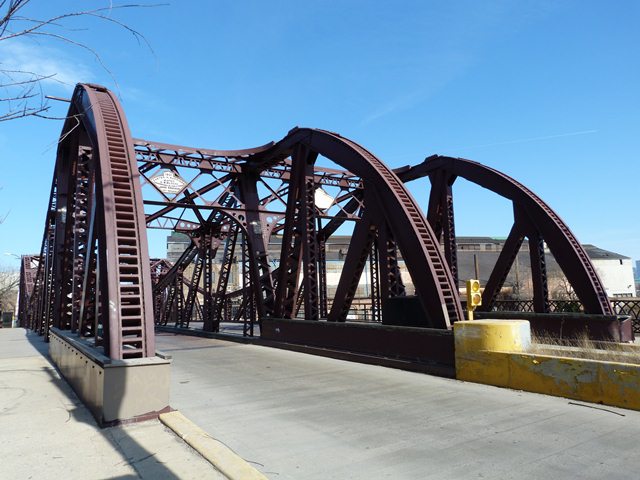We Recommend:
Bach Steel - Experts at historic truss bridge restoration.
BridgeHunter.com Phase 1 is released to the public! - Visit Now
Cortland Street Bridge
West Clybourn Place Bridge
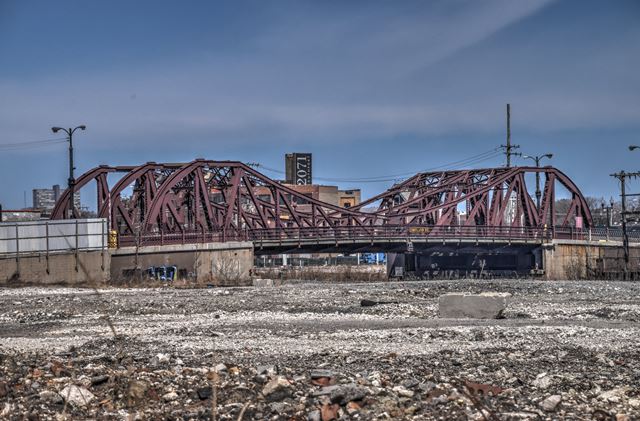
Primary Photographer(s): Nathan Holth
Bridge Documented: August 12, 2006 - April 10, 2019
Chicago: Cook County, Illinois: United States
Metal 14 Panel Rivet-Connected Pratt Through Truss, Movable: Double Leaf Bascule (Fixed Trunnion) and Approach Spans: Metal Stringer (Multi-Beam), Fixed
1901 By Builder/Contractor: American Bridge Company of New York, New York and Engineer/Design: City of Chicago
1997
128.0 Feet (39 Meters)
217.0 Feet (66.1 Meters)
36 Feet (10.97 Meters)
1 Main Span(s) and 4 Approach Span(s)
16601126625

View Information About HSR Ratings
Bridge Documentation
2019 Update: This bridge's setting is rapidly changing. When first documented in 2006, this location remained an industrial area. Today, nearly all the industrial buildings have been completely demolished, and an enormous mixed use residential/commercial complex that also includes public space is being planned.
View Archived National Bridge Inventory Report - Has Additional Details and Evaluation
View Historic American Engineering Record (HAER) Documentation For This Bridge
HAER Data Pages, PDF
Excerpts From The 1901 Annual Report of the Department of Public Works
View A Historical Article About The Bridge Substructure
Chicago is today known by bridge enthusiasts as the bascule bridge capital of the world, and this bridge is where that legacy started. The design of this bridge is that of trunnion style bascule bridge. Built from 1901 to 1902, this was in fact the first Chicago style trunnion bridge ever built. The design only became known as the "Chicago" type bascule bridge when Chicago proceeded to populate nearly every movable bridge crossing in the city with this type of bridge over the decades to come. Trunnion bascule bridges rotate up around a giant axle called the "trunnion." This design proved superior to the competing design of a rolling lift bascule, which lifts by rolling back on a short track. The rolling lift design introduced shifting dead load on the abutments, which wore out the abutments quickly in Chicago because Chicago abutments were more susceptible than abutments in other places because the land was essentially swampy and somewhat unstable.
With the Chicago bascule bridge in its infancy and city engineers perhaps occupied enough with just designing the overall structure of the bridge, the first generation bascule bridges like the Cortland Street Bridge have a somewhat cluttered and clunky appearance compared to the graceful, curved, and uncluttered appearance of the second generation bascules where engineers spent more time making the bridges aesthetically pleasing. This is not to say that the first generation bascule bridges are ugly, indeed in today's world of plain and simple bridges, their complex geometry is perhaps equally as beautiful in its own unique way. Where the later bridges would have a beauty that could be described as graceful, these first generation bridges have a beauty that could be described a geometric art. The complex patterns of triangles and curves created by the beams and trusses of this bridge give the eye much to study. Further, the first generation bridges were embellished with non-structural decorations in a way later bridges were not. For example, the Cortland Street Bridge has decorative finals placed on the top of the top chord. In addition, the placement of the plaques up in the sway bracing and on the truss members allows the plaques to have a dual function as an decorative enhancement as well. The plaques on the bridge are not the simple square bronze plaques seen on later generation bascule bridges; rather they are fancy shaped decorative plaques proudly mounted for all to see. In contrast to all of this however, the bridge-tender's tower is much more simple than the fancy stone towers seen in later generation bridge, and is instead a simple wooden building.
This bridge's truss superstructure was built by the American Bridge Company, Lassig Plant. The American Bridge Company would have been a brand new company at the time. As one of the first bridges built by the fledgling company that would become one of the leading bridge builders of the 20th Century, the Cortland Street Bridge gains additional historical significance. The Fitzsimons and Connell Company were the substructure contractors.
Construction of this bridge began with the a contract for this bridge's substructure being let on November 16, 1900 which allowed for the demolition work to begin by December 10, 1900 and be completed by January 1, 1901. The west piers were completed by July 1, 1901. The east piers were completed by October 1, 1901. The superstructure contract was let on February 20, 1901 allowing the erection of the west leaf to begin on August 12, 1901 and the east lead on November 5, 1901.
Today, the bridge no longer raises for boats, which is all too obvious due to the i-beam that was bolted on the middle of the span to lock the bridge closed.
The truss superstructure of this bridge is in good condition, and like many Chicago bascule bridges features rivets that have been replaced with bolts on select portions of the bridge. Original railings appear to have been replaced by pole railings on the bridge itself, although beautiful ornate railings that feature lattice on the bottom and a gothic arch-like design above are present on the approaches, which likely were originally present all the way across the bridge. The bridge was rehabilitated in 1983, and a plaque added to the bridge announces that the bridge was restored in 1997. The bridge was also repainted sometime between 2006 and 2009. It is good to see that this extremely important historic bridge is being maintained and preserved. As of 2014, additional repairs to the bridge are being planned, as is the restoration of the bridge tender house.
Be sure to view the excerpts from the 1901 annual report of the department of public works. It has an interesting discussion of the bridge.
The previous bridge at this location was also the first documented bridge at this location. It was a hand-turned iron/wood combination bridge built in 1873 by Fox and Howard. It was 140 feet long and 32 feet wide.
|
City Plaque 1901CARTER H. HARRISON MAYOR F. W. BLOCKI COMMISSIONER OF PUBLIC WORKS JOHN ERICSON CITY ENGINEER |
Superstructure Plaque 1901AMERICAN BRIDGE CO LASSIG PLANT CONTRACTORS FOR SUPER STRUCTURE |
Substructure Plaque 1901THE FITZSIMONS AND CONNELL CO CONTRACTORS FOR SUB STRUCTURE |
Rehabilitation Plaque 1997BRIDGE RESTORED NORTH RIVER INDUSTRIAL CORRIDOR RICHARD M. DALEY MAYOR |
Information and Findings From Chicago Landmarks DesignationGeneral Information Address: 1440 W. Cortland St. This Bridge Is A Designated Chicago Landmark |
![]()
Historic Bridges of Chicago and Cook County


Chicago and Cook County are home to one of the largest collections of historic bridges in the country, and no other city in the world has more movable bridges. HistoricBridges.org is proud to offer the most extensive coverage of historic Chicago bridges on the Internet.
General Chicago / Cook County Bridge Resources
Chicago's Bridges - By Nathan Holth, author of HistoricBridges.org, this book provides a discussion of the history of Chicago's movable bridges, and includes a virtual tour discussing all movable bridges remaining in Chicago today. Despite this broad coverage, the book is presented in a compact format that is easy to take with you and carry around for reference on a visit to Chicago. The book includes dozens of full color photos. Only $9.95 U.S! ($11.95 Canadian). Order on Amazon.
Chicago River Bridges - By Patrick T. McBriarty, this is a great companion to Holth's book shown above. This much larger book offers an extremely in-depth exploration of Chicago's movable highway bridges, including many crossings that have not existed for many years. Order Now Direct From The Publisher! or order on Amazon.
View Historic American Engineering Record (HAER) Overview of Chicago Bascule Bridges (HAER Data Pages, PDF)
Chicago Loop Bridges - Chicago Loop Bridges is another website on the Internet that is a great companion to the HistoricBridges.org coverage of the 18 movable bridges within the Chicago Loop. This website includes additional information such as connections to popular culture, overview discussions and essays about Chicago's movable bridges, additional videos, and current news and events relating to the bridges.
Additional Online Articles and Resources - This page is a large gathering of interesting articles and resources that HistoricBridges.org has uncovered during research, but which were not specific to a particular bridge listing.
This bridge is tagged with the following special condition(s): Arch Lattice Railing and Unorganized Photos
![]()
Photo Galleries and Videos: Cortland Street Bridge
2019 Bridge Photo-Documentation
Original / Full Size PhotosA collection of overview and detail photos. This gallery offers photos in the highest available resolution and file size in a touch-friendly popup viewer.
Alternatively, Browse Without Using Viewer
![]()
2019 Bridge Photo-Documentation
Mobile Optimized PhotosA collection of overview and detail photos. This gallery features data-friendly, fast-loading photos in a touch-friendly popup viewer.
Alternatively, Browse Without Using Viewer
![]()
2006 Bridge Photo-Documentation
Original / Full Size PhotosA collection of overview and detail photos. This gallery offers photos in the highest available resolution and file size in a touch-friendly popup viewer.
Alternatively, Browse Without Using Viewer
![]()
2006 Bridge Photo-Documentation
Mobile Optimized PhotosA collection of overview and detail photos. This gallery features data-friendly, fast-loading photos in a touch-friendly popup viewer.
Alternatively, Browse Without Using Viewer
![]()
2009 Bridge Photo-Documentation
Original / Full Size PhotosAdditional overview and detail photos, taken shortly after a repainting project. This gallery offers photos in the highest available resolution and file size in a touch-friendly popup viewer.
Alternatively, Browse Without Using Viewer
![]()
2009 Bridge Photo-Documentation
Mobile Optimized PhotosAdditional overview and detail photos, taken shortly after a repainting project. This gallery features data-friendly, fast-loading photos in a touch-friendly popup viewer.
Alternatively, Browse Without Using Viewer
![]()
Additional Unorganized Photos
Original / Full Size PhotosA supplemental collection of photos that are from additional visit(s) to the bridge and have not been organized or captioned. This gallery offers photos in the highest available resolution and file size in a touch-friendly popup viewer.
Alternatively, Browse Without Using Viewer
![]()
Additional Unorganized Photos
Mobile Optimized PhotosA supplemental collection of photos that are from additional visit(s) to the bridge and have not been organized or captioned. This gallery features data-friendly, fast-loading photos in a touch-friendly popup viewer.
Alternatively, Browse Without Using Viewer
![]()
Bumpercam: Westbound Crossing: Rush Hour
Full Motion VideoNote: The downloadable high quality version of this video (available on the video page) is well worth the download since it offers excellent 1080 HD detail and is vastly more impressive than the compressed streaming video. Streaming video of the bridge. Also includes a higher quality downloadable video for greater clarity or offline viewing.
![]()
Maps and Links: Cortland Street Bridge
Coordinates (Latitude, Longitude):
Search For Additional Bridge Listings:
Bridgehunter.com: View listed bridges within 0.5 miles (0.8 kilometers) of this bridge.
Bridgehunter.com: View listed bridges within 10 miles (16 kilometers) of this bridge.
Additional Maps:
Google Streetview (If Available)
GeoHack (Additional Links and Coordinates)
Apple Maps (Via DuckDuckGo Search)
Apple Maps (Apple devices only)
Android: Open Location In Your Map or GPS App
Flickr Gallery (Find Nearby Photos)
Wikimedia Commons (Find Nearby Photos)
Directions Via Sygic For Android
Directions Via Sygic For iOS and Android Dolphin Browser
USGS National Map (United States Only)
Historical USGS Topo Maps (United States Only)
Historic Aerials (United States Only)
CalTopo Maps (United States Only)

